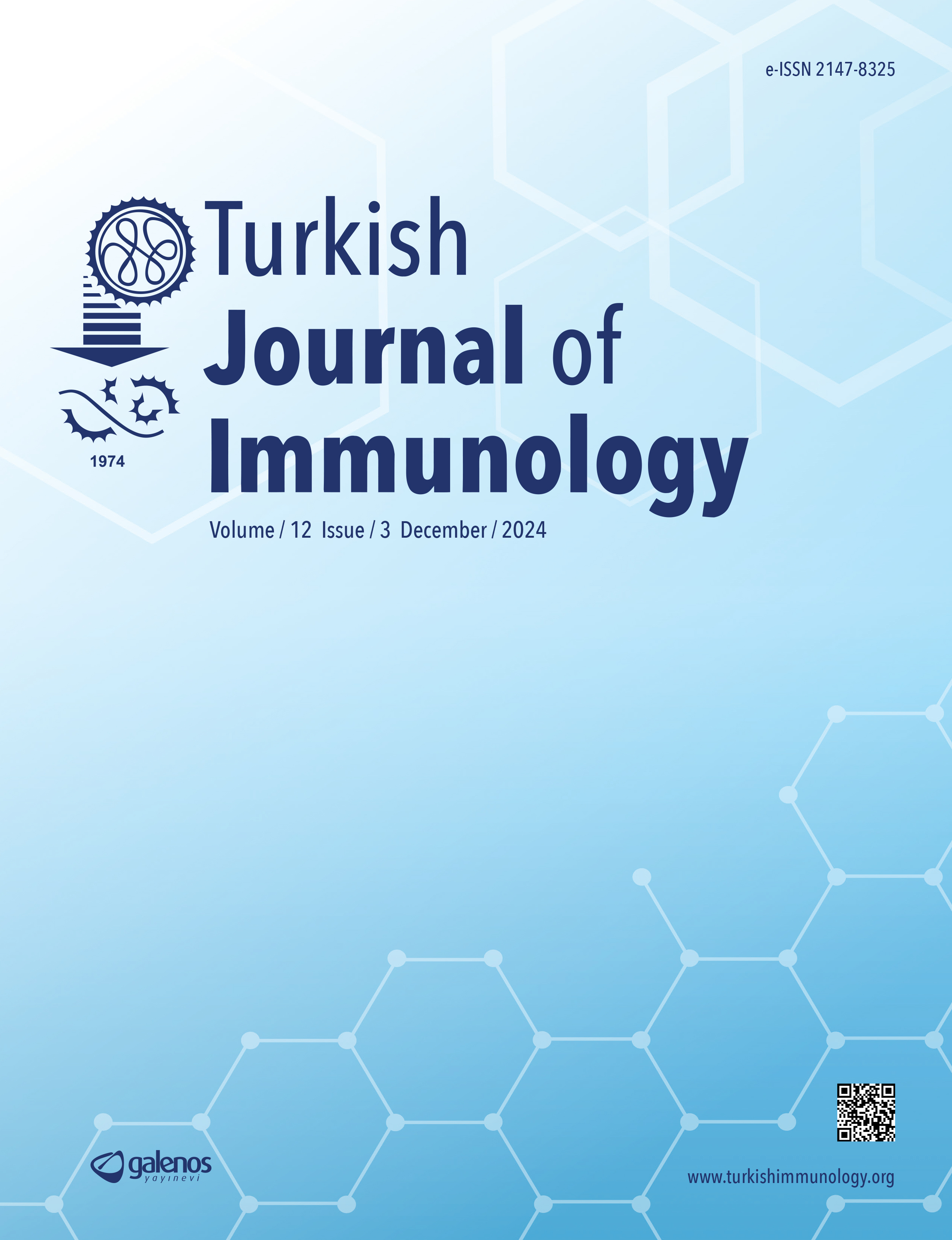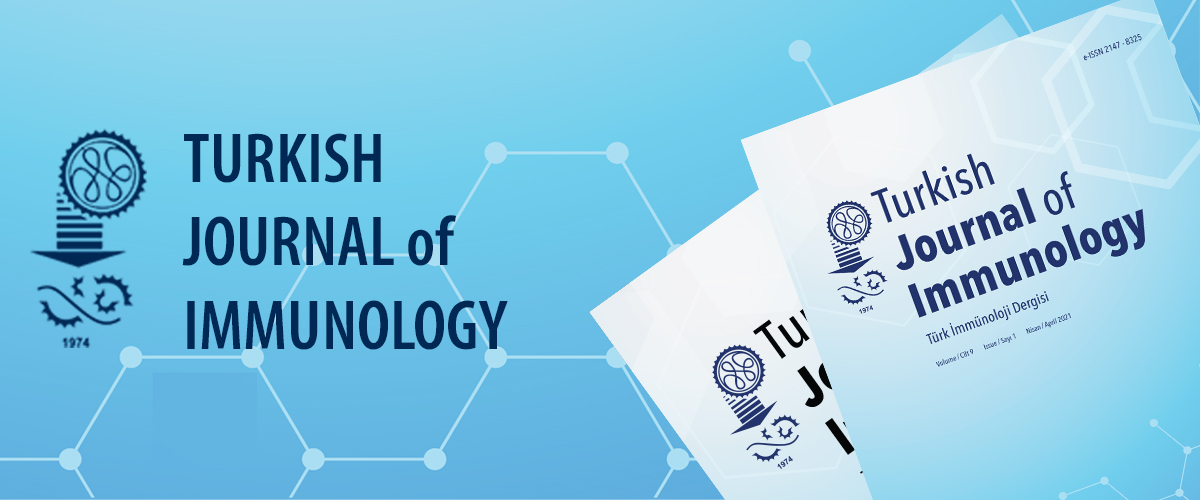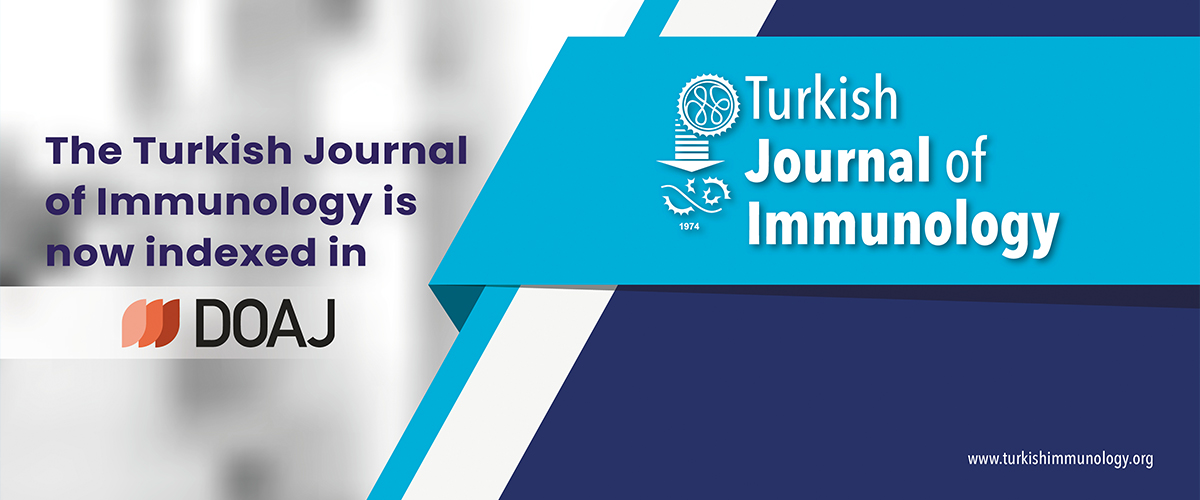INSTRUCTIONS TO AUTHORS
Turkish Journal of Immunology (e-ISSN 2147-8325), accepts original articles, short communications, invited reviews and editorial papers, on condition that they have not been published elsewhere previously but in abstract form. The journal accepts manuscripts in English to be published online.
Turkish Journal of Immunology does not charge any article submission or processing charges.
A manuscript will be considered only with the understanding that it is an original contribution
that has not been published elsewhere.
In addition, the editors encourage the submission of book reviews, meeting reports and correspondence related to the field of immunology. Turkish Journal of Immunology is the official and periodic publication of the Turkish Society of Immunology with scientific content; it is published three times a year (April, August and December).
The official abbreviation of the Turkish Journal of Immunology is TJI, however, it should be denoted as Turk J Immunol when referenced. In the international indexes and databases, the name of the journal has been registered as Turkish Journal of Immunology and abbreviated as Turk J Immunol.
The scientific, ethical liability of the manuscripts and the copyright of the manuscripts belongs to the authors. Authors are responsible for the contents of the manuscript and accuracy of the references. All manuscripts submitted for publication must be accompanied by the Copyright Agreement Form. By signing the Copyright Agreement Form, authors retain the copyright of their work and agree that the article, if accepted for publication by the Turkish Journal of Immumology will be licensed under a Creative Commons Attribution-NonCommercial-NoDerivatives 4.0 (CC BY-NC-ND). The authors agree to transfer the commercial rights to the Turkish Society of Immunology when the article is accepted for publication. Once this form, signed by all the authors, has been submitted, it is understood that neither the manuscript nor the data it contains have been submitted elsewhere or previously published and authors declare the statement of scientific contributions and responsibilities of all authors. All manuscripts submitted to the Turkish Journal of Immunology are screened for plagiarism using the iThenticate software. Results indicating plagiarism may result in manuscripts being returned or rejected.
Experimental, clinical and drug studies requiring approval by an ethics committee must be submitted to the Turkish Journal of Immunology with an ethics committee approval report confirming that the study was conducted in accordance with international agreements and the Declaration of Helsinki (revised 2013) (https://www.wma.net/policies-post/wma-declaration-of-helsinki-ethical-principles-for-medical-research-involving-human-subjects/). The approval of the ethics committee and the fact that informed consent was given by the patients should be indicated in the Materials and Methods section. In experimental animal studies, the authors should indicate that the procedures followed were in accordance with animal rights as per the Guide for the Care and Use of Laboratory Animals (http://oacu.od.nih.gov/regs/guide/guide.pdf) and they should obtain animal ethics committee approval. If the article includes any direct or indirect commercial links or if any institution provided material support to the study, authors must state in the cover letter that they have no relationship with the commercial product, drug, pharmaceutical company, etc. concerned; or specify the type of relationship (consultant, other agreements), if any.
Authors must provide a statement on the absence of conflicts of interest among the authors and provide authorship contributions.
The Turkish Journal of Immunology is an independent international journal based on single-blind peer-review principles. Reviewers are selected among independent experts who have publications and citations in the international on the subject of the article.
The manuscript is assigned to the Editor-in-Chief, who reviews the manuscript and makes an initial decision based on manuscript quality and editorial priorities. Manuscripts that pass initial evaluation are sent for external peer review, and the Editor-in-Chief assigns an Associate Editor. The Associate Editor sends the manuscript to three reviewers (internal and/or external reviewers). The reviewers must review the manuscript within 21 days.
The Associate Editor recommends a decision based on the reviewers’ recommendations and returns the manuscript to the Editor-in-Chief. The Editor-in-Chief makes a final decision based on editorial priorities, manuscript quality, and reviewer recommendations. If there are any conflicting recommendations from reviewers, the Editor-in-Chief can assign a new reviewer.
The scientific board guiding the selection of the papers to be published in the Journal consists of elected experts of the Journal and if necessary, selected from national and international authorities. The Editor-in-Chief, Associate Editors, biostatistics expert and English language consultant may make minor corrections to accepted manuscripts that do not change the main text of the paper.
In case of any suspicion or claim regarding scientific shortcomings or ethical infringement, the Journal reserves the right to submit the manuscript to the supporting institutions or other authorities for investigation. The Journal accepts the responsibility of initiating action but does not undertake any responsibility for an actual investigation or any power of decision.
The Editorial Policies and General Guidelines for manuscript preparation specified below are based on “Recommendations for the Conduct, Reporting, Editing, and Publication of Scholarly Work in Medical Journals (ICMJE Recommendations)” by the International Committee of Medical Journal Editors (2013, archived at http://www.icmje.org/).
Preparation of research articles, systematic reviews and meta-analyses must comply with study design guidelines:
CONSORT statement for randomized controlled trials (Moher D, Schultz KF, Altman D, for the CONSORT Group. The CONSORT statement revised recommendations for improving the quality of reports of parallel group randomized trials. JAMA 2001; 285: 1987-91) (http://www.consort-statement.org/);
PRISMA statement of preferred reporting items for systematic reviews and meta-analyses (Moher D, Liberati A, Tetzlaff J, Altman DG, The PRISMA Group. Preferred Reporting Items for Systematic Reviews and Meta-Analyses: The PRISMA Statement. PLoS Med 2009; 6(7): e1000097.) (http://www.prisma-statement.org/);
STARD checklist for the reporting of studies of diagnostic accuracy (Bossuyt PM, Reitsma JB, Bruns DE, Gatsonis CA, Glasziou PP, Irwig LM, et al., for the STARD Group. Towards complete and accurate reporting of studies of diagnostic accuracy: the STARD initiative. Ann Intern Med 2003;138:40-4.) (http://www.stard-statement.org/);
STROBE statement, a checklist of items that should be included in reports of observational studies (http://www.strobe-statement.org/);
MOOSE guidelines for meta-analysis and systemic reviews of observational studies (Stroup DF, Berlin JA, Morton SC, et al. Meta-analysis of observational studies in epidemiology: a proposal for reporting Meta-analysis of observational Studies in Epidemiology (MOOSE) group. JAMA 2000; 283: 2008-12).
SUBMISSION OF MANUSCRIPTS
All manuscripts must be submitted via the online submission system after logging on to the website http://jag.journalagent.com/tji/. Authors who have any queries can contact the following addresses:
Editor in Chief
Prof. Dr. Günnur Deniz
Address: İstanbul University, DETAE, Department of Immunology, Vakıf Gureba St., 34393 Şehremini, İstanbul, Turkey
E-mail: [email protected]
Phone: 0212 - 414 20 97
Fax: 0212 - 532 41 71
Managing Editor
Prof. Dr. Akif Turna
Address: İstanbul University-Cerrahpaşa, Cerrahpaşa Faculty of Medicine, Department of Chest Disease, İstanbul, Turkey
E-mail: [email protected]
Phone: 0212 414 3000 (Internal: 63500)
Fax: 0216 411 3675
GENERAL GUIDELINES
Manuscripts can only be submitted electronically through the Journal Agent website (http://jag.journalagent.com/tji/)
after creating an account and a password. This system allows online submission and review
The manuscripts are archived according to ICMJE, Index Medicus (Medline/PubMed) and Ulakbim-Turkish Medicine Index Rules.
Format: Manuscripts should be prepared using Microsoft Word, size A4 with 2.5 cm margins on all sides, 12 pt Arial font and 1.5 line spacing.
Abbreviations: Abbreviations should be defined at first mention and used consistently thereafter. Internationally accepted abbreviations should be used; refer to scientific writing guides as necessary.
Cover letter: The cover letter should include statements about manuscript type, single-journal submission affirmation, conflict of interest statement, sources of outside funding, equipment (if applicable), approval of language for articles in English and approval of statistical analysis for original research articles.
Use of Large Language Models and Generative AI Tools
AI tools cannot meet the requirements for authorship as they cannot take responsibility for the submitted work. As non-legal entities, they cannot assert the presence or absence of conflicts of interest nor manage copyright and license agreements. Authors who use AI tools in the writing of a manuscript, production of images or graphical elements of the paper, or in the collection and analysis of data, must be transparent how the AI tool was used and which tool was used. Authors are fully responsible for the content of their manuscript, even those parts produced by an AI tool, and are thus liable for any breach of publication ethics. COPE Position Statement on Authorship and AI tools. Detailed information about the statement can be accessed at https://publicationethics.org/cope-position-statements/ai-author
After reviewing the COPE statement, the editors of the Turkish Journal of Immunology have decided that papers should include a statement in a section called Declaration Regarding the Use of AI and AI-Assisted Technologies to let readers know if AI or AI-assisted tools were used in the writing process. It's important to remember that all authors are responsible for the content of their work. This declaration does not apply to the use of basic tools for checking grammar, spelling, or references (such as Mendeley, EndNote, Zotero, and others). If there is nothing to declare, there is no need to add a statement.
It is suggested that authors follow this format when preparing their statement:
During the preparation of this work, the author(s) utilized [NAME OF TOOL(S) USED] to [DESCRIPTION OF HOW THE TOOL(S) WERE UTILIZED AND HOW THE VALIDITY OF THE OUTPUTS WAS EVALUATED]. After carefully reviewing and editing the content as necessary, full responsibility for the publication's content is taken by the author(s). This incorporation of AI tool usage primarily impacted [SPECIFY WHICH ASPECTS OF THE STUDY, ARTICLE CONTENTS, DATA, OR SUPPORTING FILES WERE AFFECTED/GENERATED].
Example:
During the preparation of this work, the author(s) utilized OpenAI's ChatGPT to generate summaries of research articles related to the topic. These summaries were evaluated by comparing them to manually written summaries by experts in the field. Upon confirming the accuracy and relevance of the generated summaries, they were integrated into the literature review section of the manuscript. After carefully reviewing and editing the content as necessary, full responsibility for the publication's content is taken by the author(s). This incorporation of AI tool usage primarily impacted the efficiency of literature review process and the comprehensiveness of the gathered research insights.
CLINICAL TRIAL POLICY
All clinical trials, which are any research projects that prospectively assign individuals or a group of people to an intervention, with or without concurrent comparison or control groups, in order to study the relationship between a health-related intervention and a health outcome, must be registered in a public trials registry acceptable to the International Committee of Medical Journals Editors (ICMJE). Authors of randomized controlled trials must adhere to the CONSORT guidelines , and provide both a CONSORT checklist (for protocols, see the SPIRIT guidance) and flow diagram. We require that you choose the MS Word template at www.consort-statement.org for the flow chart and cite/upload it in the manuscript as a figure. In addition, submitted manuscripts must include the unique registration number in the Abstract as evidence of registration. Starting from August 2024, submitted manuscripts must include the unique registration number in the Abstract as evidence of registration.
You can register for clinical trials by visiting the following link:
https://clinicaltrials.gov/
To register the relevant record in the system and learn more about the protocol to be followed, please review the link below: https://classic.clinicaltrials.gov/ct2/manage-recs/how-register
REFERENCES
Authors are solely responsible for the accuracy of all references.
In-text citations: References should be indicated in parantheses immediately before the period/full stop of the relevant sentence. If the author(s) of a reference is/are indicated at the beginning of the sentence, this reference should be written in parantheses immediately after the author’s name. If relevant research has been conducted in Turkey or by Turkish investigators, these studies should be given priority while citing the literature.
Presentations presented in congresses, unpublished manuscripts, theses, Internet addresses, and personal interviews or experiences should not be indicated as references. If such references are used, they should be indicated in parentheses at the end of the relevant sentence in the text, without reference number and written in full, in order to clarify their nature.
References section: References should be numbered consecutively in the order in which they are first mentioned in the text. All authors should be listed regardless of number. The titles of journals should be abbreviated according to the style used in the Index Medicus. References should be written according to the examples below and all authors should be presented in references up to 6 authors, reference tags with more authors than 6 should be abbreviated with et al.
Reference Format
Journal: Last name(s) of the author(s) and initials, article title, publication title and its original abbreviation, publication date, volume, the inclusive page numbers. Example: Collin JR, Rathbun JE. Involutional entropion: a review with evaluation of a procedure. Arch Ophthalmol. 1978;96:1058-64.
Book: Last name(s) of the author(s) and initials, chapter title, book editors, book title, edition, place of publication, date of publication and inclusive page numbers of the extract cited.
Example: Herbert L. The Infectious Diseases (1st ed). Philadelphia; Mosby Harcourt; 1999:11;1-8.
Book Chapter: Last name(s) of the author(s) and initials, chapter title, book editors, book title, edition, place of publication, date of publication and inclusive page numbers of the cited piece.
Example: O’Brien TP, Green WR. Periocular Infections. In: Feigin RD, Cherry JD, eds. Textbook of Pediatric Infectious Diseases (4th ed). Philadelphia; W.B. Saunders Company;1998:1273-78.
Books in which the editor and author are the same person: Last name(s) of the author(s) and initials, chapter title, book editors, book title, edition, place of publication, date of publication and inclusive page numbers of the cited piece.
Example: Solcia E, Capella C, Kloppel G. Tumors of the exocrine pancreas. In: Solcia E, Capella C, Kloppel G, eds. Tumors of the Pancreas. 2nd ed. Washington: Armed Forces Institute of Pathology; 1997:145-210.
TABLES, GRAPHICS, FIGURES, AND IMAGES
All visual materials together with their legends should be located on separate pages that follow the main text. Explanations of figures, pictures, tables and figures should be added at the end of the article.
Images:
Images (pictures) should be numbered and include a brief title. Permission to reproduce pictures that were
published elsewhere must be included. All pictures should be of the highest quality possible, in JPEG format,
and at a minimum resolution of 300 dpi.
Tables, Graphics, Figures:
All tables, graphics or figures should be enumerated according to their sequence within the text and a
brief descriptive caption should be written. Any abbreviations used should be defined in the accompanying legend.
Tables in particular should be explanatory and facilitate readers’ understanding of the manuscript,
and should not repeat data presented in the main text.
BIOSTATISTICS
To ensure controllability of the research findings, the study design, study sample, and the methodological approaches and applications should be explained and their sources should be presented.
The “p” value defined as the limit of significance along with appropriate indicators of measurement error and uncertainty (confidence interval, etc.) should be specified. Statistical terms, abbreviations and symbols used in the article should be described and the software used should be defined. Statistical terminology (random, significant, correlation, etc.) should not be used in non-statistical contexts.
All results of data and analysis should be presented in the “Results” section as tables, figures and graphics; biostatistical methods used and application details should be presented in the “Materials and Methods” section or under a separate title.
MANUSCRIPT TYPES
Original Articles
Clinical research should comprise clinical observation, new techniques or laboratories studies. Original research articles should include title, structured abstract, key words relevant to the content of the article, introduction, materials and methods, results, discussion, study limitations, conclusion references, tables/figures/images and acknowledgement sections. Title, abstract and key words should be written in English. The manuscript should be formatted in accordance with the above-mentioned guidelines and should not exceed sixteen A4 pages.
Title Page: This page should include the title of the manuscript, short title, name(s) of the authors and author information. The following descriptions should be stated in the given order:
- Title of the manuscript (English), as concise and explanatory as possible, including no abbreviations, up to 135 characters
- Short title (English), up to 60 characters
- Name(s) and surname(s) of the author(s) (without abbreviations and academic titles) and affiliations
- Name, address, e-mail, phone and fax number of the corresponding author
- The place and date of scientific meeting in which the manuscript was presented and its abstract published in the abstract book, if applicable
Abstract: The abstract of the manuscript should be written in English and consist of maximum 250 words.
References should not be cited in the abstract. Use of abbreviations should be avoided as much as possible; if
any abbreviations are used, they must be taken into consideration independently of the abbreviations used in the text.
For original articles, the structured abstract should include the following sub-headings:
Objectives: The aim of the study should be clearly stated.
CORRESPONDENCE
All correspondence should be directed to the Editorial Board of Turkish Journal of Immunology:
Society and Journal Websites
www.turkimmunoloji.org.tr (Turkish Society of Immunology)
www.turkishimmunology.org (Turkish Journal of Immunology)
Turkish Society of Immunology
Doğpa Ticaret AŞ Blok Yıldız St No 55 34353 Beşiktaş - İstanbul, Turkey
Phone: +90 212 - 414 20 97
Website: www.turkimmunoloji.org.tr
Communication
Editorial Contact Person
E-mail: [email protected]





















